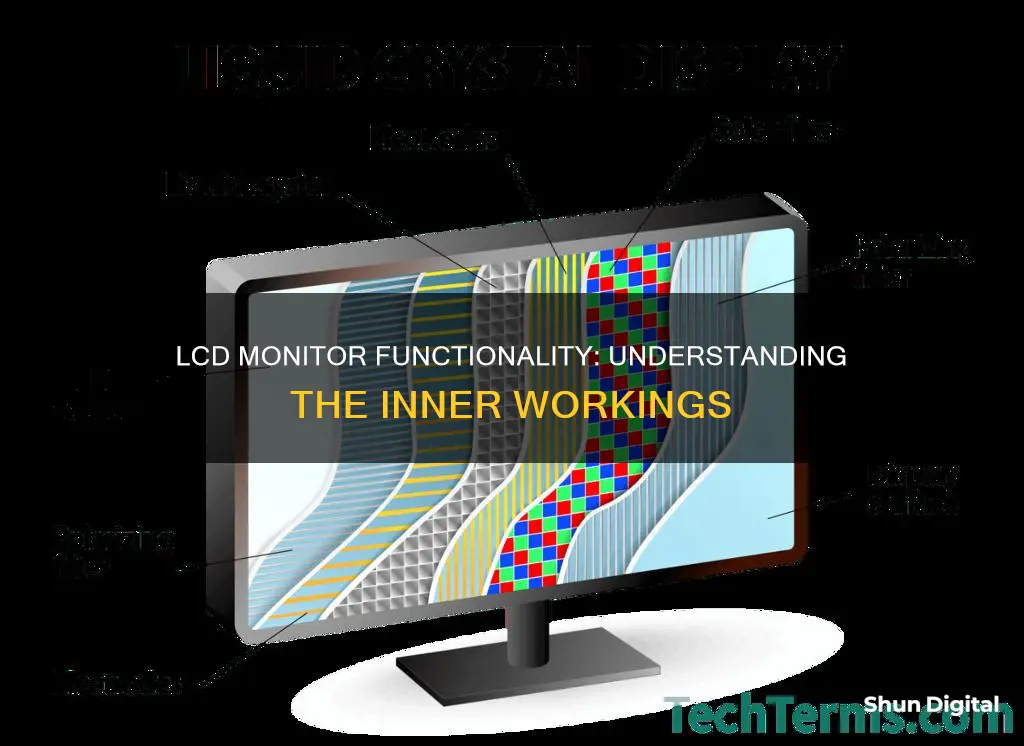
Liquid Crystal Display (LCD) monitors are a type of flat-panel display that has become the standard for screens, replacing the older cathode ray tube (CRT) technology. LCD monitors are made of a substance that is permanently in a liquid state but has some properties inherent in crystal bodies. They use liquid crystals to control the passage of light and create images. The liquid crystals are placed between two pieces of polarized glass, also called substrate, and a backlight is used to illuminate the screen. LCDs are known for their thin profile, energy efficiency, and good colour reproduction. They are commonly used in laptops, televisions, computer monitors, smartphones, and other electronic devices.
| Characteristics | Values |
|---|---|
| Type | Flat panel display |
| Function | Displaying images |
| Technology | LCD technology |
| Use Cases | Smartphones, televisions, computer monitors, instrument panels, aircraft cockpit displays, indoor and outdoor signage |
| Advantages | Thinner, cheaper, less power consumption, better picture quality, larger resolutions |
| Disadvantages | Prone to image persistence, uneven backlighting, slow response times, limited viewing angles, light leakage, burn-in effect |
| Resolution | Depends on the number of pixels (e.g. 4K display: 3840 x 2160 or 4096 x 2160 pixels) |
| Pixel | Made up of three subpixels: red, blue and green |
| Backlight | Lit by a backlight, with pixels switched on and off electronically |
| Display Grid | Passive matrix or active matrix (thin-film transistor) |
| Types | Twisted Nematic (TN), In Panel Switching (IPS), Vertical Alignment (VA), Advanced Fringe Field Switching (AFFS) |
What You'll Learn

LCD monitors use liquid crystals to block light and create images
Liquid-crystal displays (LCDs) are flat-panel displays that use liquid crystals to block light and create images. LCDs are available to display arbitrary images (as in a general-purpose computer display) or fixed images with low information content. They use the same basic technology, except that arbitrary images are made from a matrix of small pixels, while other displays have larger elements.
LCDs are made of a substance that is permanently in a liquid state but has some properties inherent in crystal bodies. They are made of two pieces of polarized glass (also called substrate) that contain a liquid crystal material between them. A backlight creates light that passes through the first substrate. At the same time, electrical currents cause the liquid crystal molecules to align to allow varying levels of light to pass through to the second substrate and create the colours and images that you see.
LCDs use the light-modulating properties of liquid crystals combined with polarizers to display information. Liquid crystals do not emit light directly but instead use a backlight or reflector to produce images in colour or monochrome. Each pixel on an LCD screen consists of three subpixels (red, green, and blue). Light passes through the liquid crystals and colour filters to create the image you see on LCD screens.
LCDs can either be normally on (positive) or off (negative), depending on the polarizer arrangement. For example, a character positive LCD with a backlight has black lettering on a background that is the colour of the backlight, and a character negative LCD has a black background with the letters being of the same colour as the backlight.
LCDs are used in a wide range of applications, including LCD televisions, computer monitors, instrument panels, aircraft cockpit displays, and indoor and outdoor signage. Small LCD screens are common in LCD projectors and portable consumer devices such as digital cameras, watches, calculators, and mobile telephones, including smartphones.
Electricity Monitors: Accurate or Deceitful?
You may want to see also

LCD screens are made up of millions of pixels
A liquid crystal display (LCD) monitor is a computer monitor or display that uses LCD technology to show clear images. LCD screens are made up of millions of pixels, each consisting of three subpixels: red, green, and blue (RGB). The quality of a display is often referred to by its number of pixels; for example, a 4K display has 3840 x 2160 or 4096 x 2160 pixels.
LCD screens use liquid crystals, which are substances with properties of both liquids and solids, to create images. When an electric current is applied, the liquid crystals align to allow or block light, forming the images we see on the display. Each pixel on an LCD screen is made up of three subpixels (red, green, and blue), and by combining these primary colours for each pixel, any colour can be reproduced.
The liquid crystal panel is illuminated by a light source, which is usually a backlight. The light passes through the first of two panels of glass, called the substrate, and then through a thin layer of liquid crystals before reaching the second substrate. The panels have flutes that direct the crystals, giving them a distinctive orientation. The flutes are parallel on each panel but perpendicular to each other. This distinctive orientation of the liquid crystals allows them to manipulate the light travelling through them and create the images we see on LCD screens.
LCD screens have largely replaced the older cathode ray tube (CRT) technology due to their thinner form factor, improved energy efficiency, and better colour accuracy. However, newer display technologies such as OLEDs and QLEDs are now starting to replace LCDs.
Monitoring WiFi Usage: Track, Analyze, and Optimize Your Network
You may want to see also

LCDs are more energy-efficient than older CRT monitors
Liquid-crystal displays (LCDs) are more energy-efficient than older cathode-ray tube (CRT) monitors. CRT displays are power-hungry, with a typical 19-inch display consuming about 100 watts. In comparison, the average power consumption for a 19-inch LCD display is approximately 45 watts. This difference is due to the underlying technology of LCDs, which work on the principle of blocking light rather than emitting it. LCDs use a backlight to produce images, while CRTs emit light directly.
The lower power consumption of LCDs leads to reduced heat generation. LCDs produce less heat than CRTs, which is advantageous in maintaining a comfortable working environment and reducing the need for additional cooling. Additionally, the compact and lightweight design of LCDs makes them easier to transport and mount, providing flexibility in terms of placement and arrangement.
The advancements in LCD technology have resulted in improved colour accuracy and viewing angles. LCDs with In-Plane Switching (IPS) panels are known for their superior colour accuracy, viewing angles, and image quality. This enhancement addresses the limitations of early LCD variants, which struggled to match the colour and picture quality of CRT monitors.
The environmental impact of LCDs is also favourable. The production of CRTs has declined due to cost and environmental concerns. LCDs are more environmentally friendly than CRTs as they consume less energy and do not contain hazardous materials like phosphors, which can degrade over time in CRTs, affecting colour quality.
In summary, LCDs offer significant advantages over CRTs in terms of energy efficiency, heat generation, design flexibility, colour accuracy, and environmental impact. These benefits, along with continuous technological improvements, have contributed to the widespread adoption of LCDs as the current standard for displays.
Monitoring Linux Process Usage: A Comprehensive Guide
You may want to see also

LCDs are thinner than cathode ray tube (CRT) technology
The difference in thickness between LCDs and CRTs is significant. An LCD monitor can be up to 80% smaller in total mass than a CRT monitor of the same screen size. This makes LCDs easier to handle and more convenient for desktop setups, as they take up less space. The compact size and lightweight design of LCDs also make them more portable and easier to transport than CRTs.
The thickness of CRTs is due to their use of cathode ray tubes, which are deep and bulky. In contrast, LCDs use liquid crystals that are contained within thin layers. This allows LCDs to be much thinner and lighter than CRTs.
The thin design of LCDs is also advantageous for wall mounting or mounting on an arm. This further reduces the amount of space required, as LCDs can be attached to walls or other surfaces, freeing up desk space.
The compact and thin design of LCDs has contributed to their widespread adoption. LCDs have replaced CRTs in most applications, including laptop computers, desktop monitors, televisions, and various consumer devices. The thinner design of LCDs not only saves space but also enables more flexible installation options.
Triple Monitor Setups: Size and Configuration Guide
You may want to see also

LCDs are now being replaced by new display technologies such as OLEDs
Liquid-crystal displays (LCDs) are a type of flat-panel display that uses liquid crystals to display information. They replaced the older cathode-ray tube (CRT) technology, which was bulkier, heavier, and less energy-efficient. LCDs are now found in a wide range of applications, from televisions and computer monitors to small screens in devices like digital cameras, watches, calculators, and smartphones.
LCDs have also been replaced by newer display technologies such as organic light-emitting diodes (OLEDs). OLEDs offer several advantages over LCDs:
- OLEDs use solid-state technology, allowing individual pixels to emit light in various colours and intensities without the need for a backlight. This makes OLED displays thinner and more flexible than LCDs, which require a backlight to produce images.
- OLEDs have a higher contrast ratio and better viewing angles than LCDs, providing deeper blacks and more vivid colours.
- OLEDs consume less power than LCDs, as they only light up the individual pixels needed to display an image. This is especially beneficial for battery-powered devices like smartphones.
- OLEDs have a simpler structure, using a single glass or plastic panel compared to the two panels used in LCDs.
- OLEDs do not suffer from the same level of burn-in as LCDs, where constant pressure on the screen can cause marks or discolouration.
However, OLEDs also have some drawbacks. They tend to be more expensive, and they can be more fragile than LCDs. OLED displays may also suffer from burn-in, similar to plasma-based displays. Despite these disadvantages, OLEDs are increasingly being adopted in smartphones, televisions, and other devices, offering improved visual quality and energy efficiency.
Bigger Monitors, Better Aim? Sensitivity and Screen Size Explored
You may want to see also
Frequently asked questions
LCD stands for Liquid Crystal Display.
An LCD monitor uses liquid crystals, which have properties of both liquids and solids, to create images on a screen. When an electric current is applied, the liquid crystals align to allow or block light, creating the images you see on the display.
LCD monitors offer several advantages over older display technologies such as cathode ray tube (CRT) monitors. LCD monitors are typically thinner, more energy-efficient, and cheaper than CRT monitors. They also provide good color reproduction and brightness.
There are two main types of LCD monitors: passive matrix and active matrix (also known as thin-film transistor or TFT displays). Active matrix LCDs are generally superior due to their faster response times and more precise voltage control.







